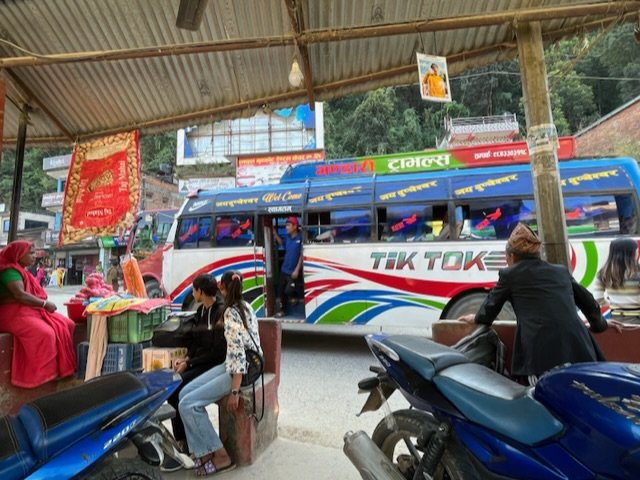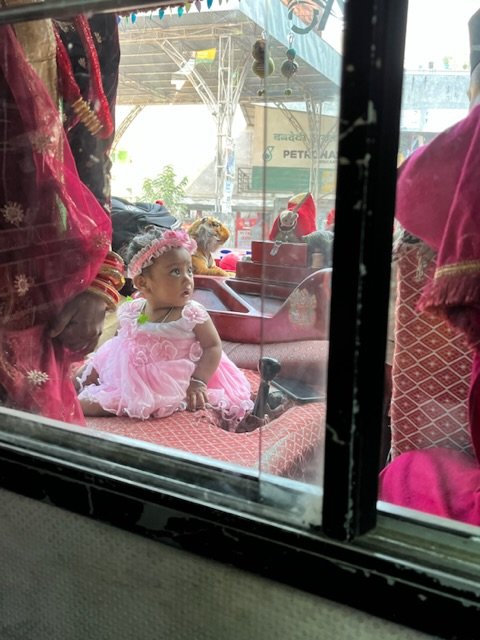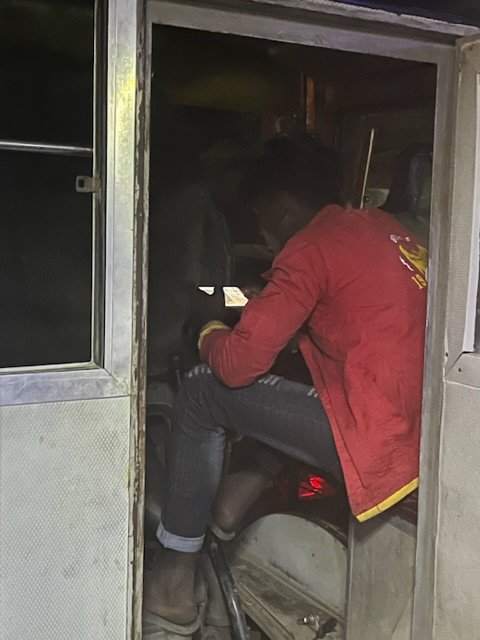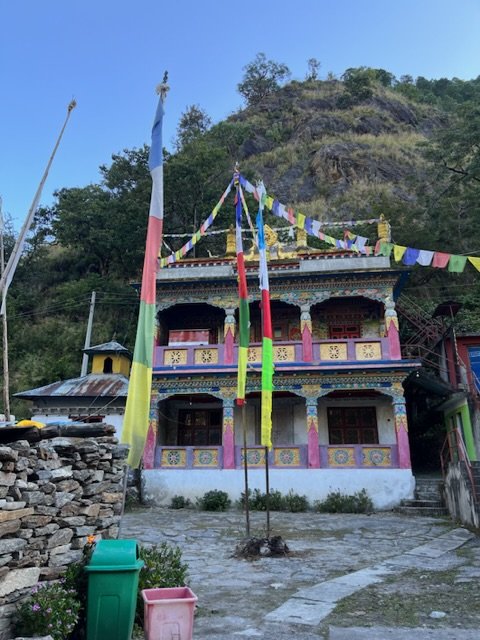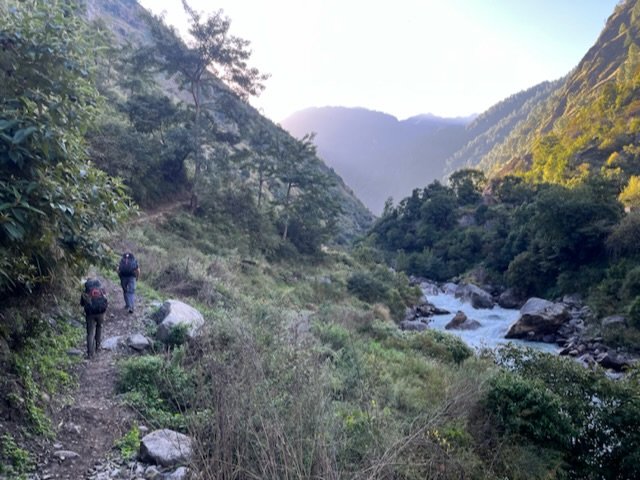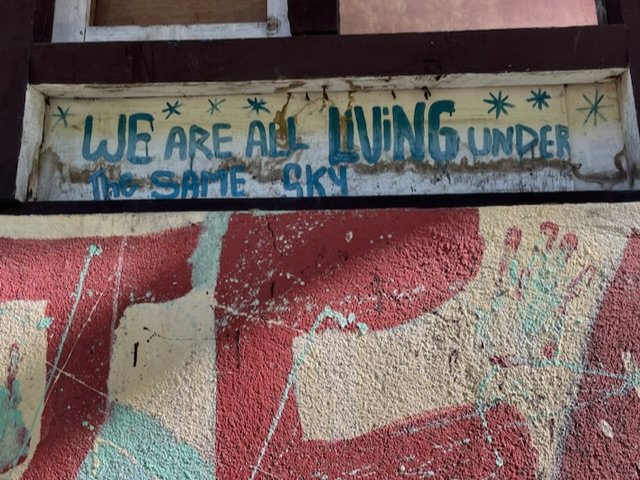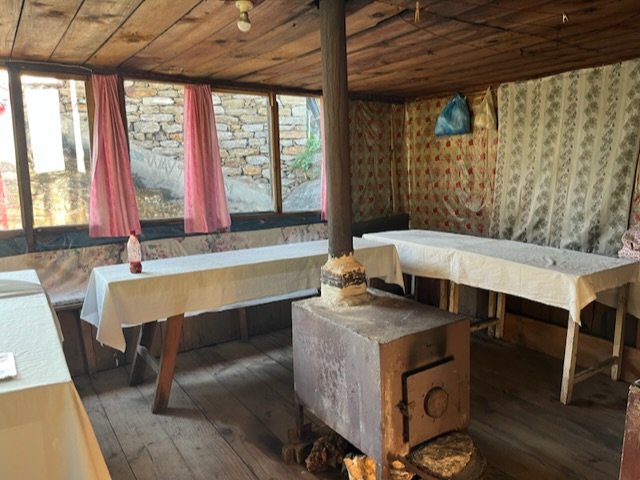Langtang Valley Trek (part 1), Nepal
If you’ve ever seen the meme of a bus rounding a corner precariously on a sheer cliff…That may be the ride to Syabrubesi, Nepal. The bus ride from Kathmandu is long. It’s only about 100 miles but takes roughly 6-8 hrs depending on stops, traffic and road conditions.
After leaving the city the road winds along the river, up through the hills and then up, and up, and up. The going is very very slow.
The ruts in the road so deep that the bus sways side to side like a ship on rough seas. I wonder how much lean a bus can take before it tips.
We leave behind the banana trees and rice fields of the lower hills and make our way up to small terraced farms of cabbage and potatoes. Long needle pine trees grow here, tall wavy grass, thick glossy shrub leaves covered in a layer of dust. The vegetation reminds me of Northern California- the foothills of the Sierras. Different plants. Similar gestalt. But the topography—that was something else. Rugged and steep slopes dropping sheer down to the valleys below. Small towns perched on the edge. Terraces carved into the hillsides where people work, live, and play. Everywhere is hard to get to. This is a dry landscape. Higher and colder with abundant water from the snowy Himalaya. Waterfalls spilling over the road, creating new ruts. Pooling up enough in some spots for our bus driver to stop, fill up his water bottles and add to the overheating engine. We stop and wait. At one pit stop a mechanic jumps on board. Takes off the engine cover in the cab, fiddles with some hoses and screws, then sits down in the drivers seat and plays a video game for a while. We sit. And wait again. Finally, some quick words are exchanged. Money changes hands. We be are back on the road.
The dress up here is different. We are closer to Tibet. The influence is apparent. A woman steps on the bus in a boldly striped skirt and head scarf. She is carrying crates covered with scraps of tarp. Lots of tiny chirping underneath. Baby chicks. She stacks the crates in the aisle next to me. She smiles. Anyone who has raised chicks indoors will recognize the sweetly sour smell. It is universal. It reminds me of home.
The road gets windier, steeper and narrower until it is a one way road with no guardrails. Crumbled rocks are obstacles on the rutted dirt roadway. This is a long bus. Despite the blaring music, the driver occasionally picks up his phone for a quick chat as we round the curves, conversation interrupted only briefly to lay his hand on the horn. It’s hard to imagine how they do this. When buses pass you could touch hands with the other passengers. The drivers stop for a quick chat through their open windows. I keep anticipating the screetch of scraping metal. It never comes. These drivers are casually expert. Occasionally there is backing up involved. The copilot hangs out the door, thumping loudly to alert the driver when to stop. Sometimes he shouts. This is not a ride for the squeamish.
There are a couple of choices when riding a bus in Nepal— try to fall asleep or look out the window, take in the passing scenery and reflect on your life. Maybe say a little prayer, if that is what you do. Every ride is different. Sometimes the music is loud. Sometimes there is a screen with a long and dramatic Bollywood film. Sometimes a musician will hop on board and play for money. Sometimes there are animals on board. And there was a time when Dylan shared his seat with several large propane tanks. These busses are beasts—delivering people and supplies. picking up and dropping off as we go from town to town. They are loud and dirty. They are old and dusty they are decorated- each one different. Each driver with his own colorfully worn out fancy cab. On every ride at least one person loses their lunch. They pass out plastic bags for those in need. The buses in a Nepal are an experience in and of themselves-- I highly recommend bus travel traveling as a full immersion in local life.
Finally arriving in the small town of Syrabubesi we find a guest house, enjoy a warm meal of dahl bhat, noodles and curry. Our room has peeling paint, big windows, and a view to the river below. The roaring sound lulls us to a deep sleep.
The guest houses in Nepal might be basic but they are filled with warmth from hosts, travelers, and friendly guides. We always learn important information and make new friends. At this layover we befriend a guide from the Everest region and his client, a young woman from Australia. Dawa, a local, joins our conversation, telling us that because of weather related trek cancellations in other regions we might find it hard to find a room up on the trail. It is also still Dashain festival, a time for gathering. Family members living in the cities are traveling to their home villages.Given that this trek is a bit more off the beaten track this is something we had not considered. Guides might pre-arrange accommodations for their clients. But independent trekkers like us don’t have the contacts or ability to make such reservations with guesthouses that are off grid. Not to worry, says Dawa. He has brother in a village up the trail. He’ll make a phone call. They have a phone carrier that works in the mountains. We will have a room. Dawa takes my phone, enters his details in case we need his help as we go.
It’s hard to know who is related in Nepal. Everyone is a brother. Everyone is a sister.
We are all connected.
And now we can message in WhatsApp.
We set out in the morning, hiking uphill all day, following the Langtang river. This is not a meandering river valley. It is a steep and steady climb along the fast moving river—up to the mountains, toward the snowy Himalaya source. The lower section of the hike is dry scrub, becoming almost jungly as we climb beside the river. Tall broadleaf trees, rhododendrons, ferns, wild ginger, bamboo. We keep our eyes open for the elusive red panda.
We pass waterfalls, cross precarious bridges, and scramble crumbling stone ledges. We arrive at the 2 guest-house village of Rimche, dropping in sweaty weariness to fill up our water bottles and rest at an outdoor table. The hostess, napping on the grass in the shade gets up to peel vegetables in a large bowl on her blanket. Her son comes out and greets us. Dawa had been true to his word.
We were expected.
Our room has thin plywood walls and the floor is creaky. One single lightbulb. And one small window. The blankets are thick.
It is perfect.
Corrugated metal walls surround the pit toilet that we access from outside. An opening in the back wall lets in views of monkeys playing in the trees at sunset.
There is no indoor plumbing. There is no refrigeration. Our hostess sleeps in a bed in the kitchen beside the fire where she cooks.
They do have WiFi.
That evening we drink an endless pot of milk tea, striking up conversation with another guest. An Aussie named Edwin. We have spent a fair bit of time in Australia and Jon’s sister lives there so we always have plenty to chat about with the Aussies (who seem to be traveling en masse this year). After a time we learn that he is a musician. He describes touring in the US, and asks us if we know Woodinville, a town not far from our home. He has recorded there. (Huh.) We ask about his band. Turns out he is Edwin White, drummer and musical director for Vance Joy. Dylan is a bit giddy. This isn’t minor league. He’s toured with the likes of Taylor Swift. But in Nepal, in this rickety little guest house he is just a guy. Kind and humble, easy to talk to. There are no frills or pretenses. We are all a little dirty, sweaty and tired. We are all in a state of awe at this place we have found ourselves in.
Just people. On a pilgrimage of sorts. Living in the moment. Even asking for a photo would have felt like a spoiler, a betrayal. After breakfast together in the early morning he headed down hill. Back to his life.
We continued our journey up…
(To be continued)

